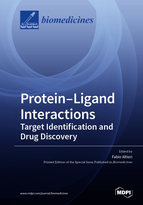Protein–Ligand Interactions: Deciphering the Molecular Targets and the Mechanisms of Action of Drugs and Natural Compounds
A special issue of International Journal of Molecular Sciences (ISSN 1422-0067). This special issue belongs to the section "Molecular Pharmacology".
Deadline for manuscript submissions: closed (31 January 2020) | Viewed by 37382
Special Issue Editor
Interests: oxidative stress; cellular biochemistry; signal transduction; protein–ligand interaction; bioactive compounds
Special Issues, Collections and Topics in MDPI journals
Special Issue Information
Dear Colleagues,
Drug discovery is a process where bioactive compounds are designed and screened either on the basis of specific molecular targets or by the identification of active ingredients from traditional medicine, as well as by serendipitous discovery. Both forward and reverse pharmacology approaches not only require a deep knowledge of the molecular processes involved in each pathological condition and disease but also the specific protein targets and the effects of drug binding on the conformation and activity of the proteins involved. An understanding of how drugs can modify and modulate specific cellular pathways and functions will be helpful during the process of drug development and clinical trials.
This Special Issue focuses on recent studies that aimed to investigate protein–ligand interactions, with a special aim to elucidate the molecular mode of action and the protein targets of drugs as well as natural compounds, and the cellular pathways involved. Indeed, protein–ligand interactions may affect both protein conformation and biological activity. However, for many bioactive compounds there is a lack of knowledge of their molecular targets, their effects on protein structure, and how they can modulate different cellular pathways and functions. Studies providing such information are welcomed and will help to elucidate the molecular basis for many drugs activity and the development of new drugs.
Prof. Dr. Fabio Altieri
Guest Editor
Manuscript Submission Information
Manuscripts should be submitted online at www.mdpi.com by registering and logging in to this website. Once you are registered, click here to go to the submission form. Manuscripts can be submitted until the deadline. All submissions that pass pre-check are peer-reviewed. Accepted papers will be published continuously in the journal (as soon as accepted) and will be listed together on the special issue website. Research articles, review articles as well as short communications are invited. For planned papers, a title and short abstract (about 100 words) can be sent to the Editorial Office for announcement on this website.
Submitted manuscripts should not have been published previously, nor be under consideration for publication elsewhere (except conference proceedings papers). All manuscripts are thoroughly refereed through a single-blind peer-review process. A guide for authors and other relevant information for submission of manuscripts is available on the Instructions for Authors page. International Journal of Molecular Sciences is an international peer-reviewed open access semimonthly journal published by MDPI.
Please visit the Instructions for Authors page before submitting a manuscript. There is an Article Processing Charge (APC) for publication in this open access journal. For details about the APC please see here. Submitted papers should be well formatted and use good English. Authors may use MDPI's English editing service prior to publication or during author revisions.
Keywords
- protein-ligand interaction
- molecular mode of actions
- target identification
- drug discovery
- bioactive agents







